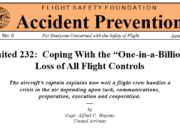
As parents, we’d all like to think that there is nowhere safer for our children than in our arms, particularly when our kids are very young. And from a nurturing or development standpoint, this is probably true. But is it true during a high-speed rejected takeoff, clear air turbulence or a runway excursion when acceleration g-forces come into play?
When traveling by air, parents generally are allowed to hold the smallest children, those under the age of 2 years, on their laps, obviating the need to buy an additional seat. However, in the United States there are no restraining devices for lap-held children that are approved for use during takeoff and landing, so parents are expected to secure these children using only their arms.
In a speech April 21 at the National Press Club in Washington, Deborah Hersman, then the outgoing chairman of the U.S. National Transportation Safety Board (NTSB), made the issue of lap-held children one of the focal points of what were essentially her farewell remarks. “Some people say the risk is small,” Hersman said. “I tell them, ‘No, a baby is small.’ We secure laptops and coffeepots, yet we do not secure our most precious cargo, our children.”
In the late 1970s, NTSB recommended that the Federal Aviation Administration research and initiate a rulemaking on the restraint of small children. After the crash of United Airlines Flight 232 at Sioux City, Iowa, 25 years ago, NTSB recommended restraints for lap-held children, “and we have been recommending it ever since,” Hersman said.
During the question-and-answer session following her speech, she said, “I couldn’t have imagined in 2004 [when she joined the NTSB] that we’d still be talking about this issue in 2014.” She described it as one of the “great disappointments” of her tenure on the board.
As soon as we wrap up this issue of AeroSafety World, I will be headed to Madrid to attend the International Air Transport Association’s (IATA’s) Cabin Operations Safety Conference. Among the conference activities are two workshops — half a day each — on child restraint devices. In its conference materials, IATA said it is seeking an “internationally recognized solution on accepted child restraint devices with a solution that is practical, affordable, operationally realistic, feasible and harmonized globally.”
I’m looking forward to the discussion, and I hope that a solution to the issue is on the horizon.
